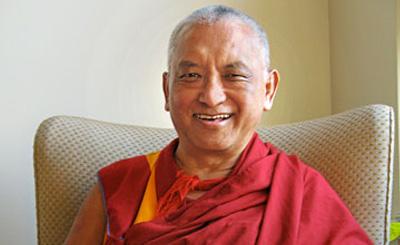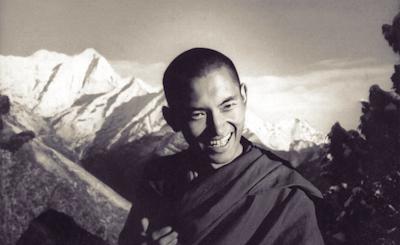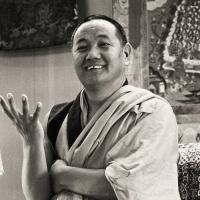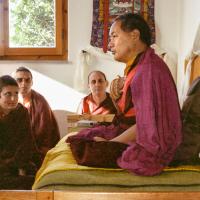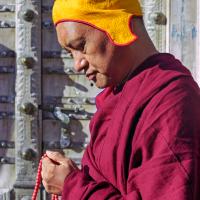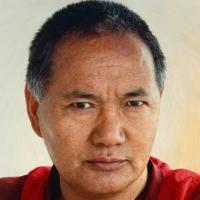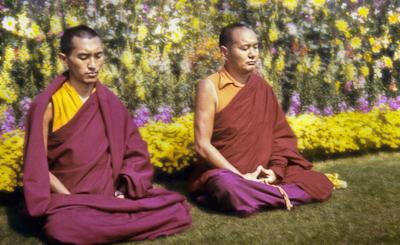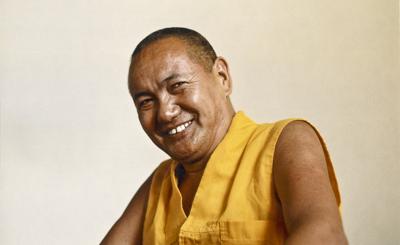The wheel of life
Here, when we recite dro la, transmigrator, in the mind, the meaning contains the whole explanation of the Wheel of Life, how we suffer because of the twelve links. Yama’s two hands hold the Wheel of Life, which signifies the cause of suffering, delusion and karma. Being under the control of that, we experience the three types of suffering. The suffering of pain is signified by the three lower realms drawn there, signifying the suffering of samsara, the suffering of pain. It doesn’t mean their suffering is only the suffering of pain. It’s not saying that desire realm devas and humans don’t also have the suffering of pain, but it’s shown like that because the heaviest suffering of pain is in the lower realms.
The suffering of change is shown by the deva and human realms.
Then, for pervasive compounding suffering, on top of the Wheel of Life there are seventeen categories. Some of the Wheel of Life drawings have these seventeen levels, which show the seventeen levels of the form realm, which has four levels of continual precise contemplation, sam den. I haven’t heard a precise translation of that, but it is sometimes translated as “absorption.” I haven’t heard whether there are different translations. It still needs a precise translation like that. It is much simpler to use the Tibetan name if it is not clear. At least you have a correct label to hold on to. So, it’s sam den inTibetan.
Anyway, within that there are different levels, making a total of seventeen levels. That signifies the form realm and that is to show pervasive compounding suffering. I don’t think there is any representation of the formless realm there in the drawing. Here, it is mainly to show that the entire suffering of samsara comes in three [types]: the suffering of pain, the suffering of change and pervasive compounding suffering. Being under the control of karma and delusion, we continuously circle in samsara, experiencing or being tormented by the suffering of pain, the suffering of change and pervasive compounding suffering. And at times, even when there are not the two other sufferings, there is still pervasive compounding suffering, particularly like the formless realm. This shows there is no freedom at all there; it is only suffering.
How that happens is shown through the twelve links. All this is in the nature of impermanence. The whole Wheel of Life is held in the mouth of the Lord of Death, showing all this is in the nature of impermanence. All of life is in the nature of impermanence and death. The whole Wheel of Life is held in the jaw of the Lord of Death, so we are already inside his jaw, because our life is in the nature of impermanence and death. That means we are supposed to remember to practice mindfulness in our everyday life; we are supposed to remember every day that we are already in the jaw of the Lord of Death, in the nature of impermanence and death. The jaw can close at any time and we can never be sure when it will be closed. We can never be sure when death will happen. It can happen at any moment. The jaw can close at any moment. That is to show our mind [why we need] to practice mindfulness in our everyday life and therefore to not waste our precious human life or human body.
Even if we are happy, we must practice Dharma; even if we are unhappy, we must practice Dharma. Even if we encounter problems, we must practice Dharma. Even if we have comfort, a happy life, we must practice Dharma. We must do pure Dharma practice, continuously. Our Dharma practice should be equal with life and life should be equal with our Dharma practice.
Therefore, when we hear dro la phän chir, with the dro la, we should remember in our mind, in our heart, the whole meaning of the Wheel of Life. While we are studying what this word dro la is supposed to be, there should be compassion in our heart toward numberless sentient beings.
The seven-limb practice: Prostrations
Through doing the seven-limb practice, we purify defilements, negative karma, and increase our merit. These are seven very important things that create enlightenment, like seven very important parts of a car or horse carriage, that help carry people to the place they wish to go. These seven very important limbs are seven important methods or practices that create enlightenment and cause us to have realizations on the path to enlightenment.
So, with the first limb, “I prostrate with my body, speech and mind, respectfully with the three doors,” even though it is not your actual body doing a full-length prostration, but just putting your palms together like this as in prostration to the merit field, still you can visualize numberless emanations of your body in the form of the deity, Thousand-arm Chenrezig, which makes it very easy to cover the entire ground. Or you could visualize just your ordinary body, but very tall like a ridge of mountains, covering the whole ground in all directions and corners, lying down before the merit field.
If you are reciting this prayer of prostration, then with your palms together in the prostration mudra, visualize numberless emanations of your body, numberless of you, having bodies like a ridge of mountains, very long, lying down in the four directions and four corners, prostrating to the merit field. If you do that, then even if it is done only one time, if you have visualized one hundred bodies then you have collected the same amount of merit as having done a hundred prostrations with your actual body, you get the same amount of merit. If you visualize billions of your body doing prostrations then you collect the same amount of merit as your actual body, numbering billions, having done prostrations, you get the same amount of merit. Especially when you visualize your actual body as huge.
My own body is very short so I tell the students who have very tall bodies that they can collect twice as much merit doing prostrations as I can. They only have to do it once, but I have to do it twice. [Rinpoche laughs] By using their tall bodies to do prostrations, they collect a lot of merit. The taller the body you have, the more the merit. That’s one great advantage. A tall body is the result of good karma. Another advantage is that the short body can’t reach something high but a tall body can. That’s another usefulness other than prostrations. It has great usefulness, great advantage to help others. Maybe sometimes there are difficulties, such as low doors or rooms, the ceiling is very low. Then you have to bend so much, so maybe sometimes there are a few difficulties. But that doesn’t happen all the time, anyway. Only joking.
You can visualize that there is no restriction, there is no resistance of mountains or buildings. You can visualize covering the whole ground, but your actual body cannot do that, even if it is like a ridge of mountains or a body that you actually have. You can’t cover the ground; there are so many buildings or mountains resisting. But by having a body like a ridge of mountains, numberless mountains, and doing prostrations, it is very easy, because you collect the same amount of merit having [visualized] that many bodies and that much length, like a ridge of mountains, as actually having that many bodies or being as big as a ridge of mountains. This is mentioned in the teachings.
I am not going to mention any details here about prostrations. Just remember when you recite prayers such as this seven-limb prayer, by seeing how you should do the meditation, you collect the most extensive merit, making your life most beneficial, most meaningful for all the sentient beings.
Then next one, as I just explained, you do the practice.
So recite “I prostrate respectfully with three doors…” and do that extensive meditation, doing prostrations. With your actual body you put your palms like this, do the prostrations to the merit field, and immediately you achieve the eight benefits or ten benefits, the last one being enlightenment.
The seven-limb practice: Offering
Then, “I offer mentally every single offering, that which is actually performed and mentally transformed.” Here the offering limb is performed, and I would like to say one thing. When I lead the offering practice, I often mention to make offering of all the extensive offerings which are in FPMT centers. Wherever there is an FPMT center gompa there are extensive offerings; many of the FPMT centers have extensive offerings, so offer all that. And then in the Aptos house where I live in the United States, there are many hundreds of water bowl offerings, and the water bowls are very big, not small, very big, very large water offerings. There are two main rooms for water offerings, with several hundred water offerings, both large and small, some upstairs and some downstairs. In just one offering room there are four thousand light offerings, with extensive light offerings on the ceiling. At nighttime there are many lights outside as well, around the house. There are also many of those lotus lights, so if it is nighttime there are many thousands of light offerings and water offerings. One nun makes offerings in one room and another nun offers on this side, so there are two offerings. Also downstairs there are flowers and food, inside and outside.
Recently, I think it might be at a center, I suggested that for the students of the organization—not just students but anyone—whenever you do a sadhana, whenever you do your practice and do this offering limb, you can always offer all those offerings there in the Aptos house, that I have performed there, that the student nuns are doing. They have dedicated their lives to set up all these offerings every day. So anyone, students of this organization, even non-students, anyone, you can use that when you do sadhanas, when you do your guru yoga practice. Any time you do the offering practice, you can offer all those flowers, all those flowers, lights and water outside and inside, all the offerings there.
And if you do that, then for those nuns who are doing so much hard work, making all those offerings, their efforts become very meaningful and everybody collects extensive merit, unbelievable merit. Anyone can use all those offerings, wherever you are. So this is what I would like to let you know.
Even if your room is very tiny and there is no place to offer, but you wish to make extensive offerings—if you don’t have time or you have no place or you can’t afford it—like this, you can offer and if you want to collect extensive merit, you can benefit, you can have quicker realizations and be able to benefit more and deeper other sentient beings.
There is also a retreat house in Washington. There are so many lights there. Right now, there are some light offerings but there are even more when the monk who takes care of the place, John Jackson, is there. John was the Vajrapani director for a long time. He worked so hard for the center for a long time, doing carpentry, building, for his whole life while he raised a family. Now all the family is grown up, all the children are grown up, they are doing jobs, so he is free. He became a fully ordained monk, not just the thirty-six vows but the two hundred and fifty-three vows. I don’t know whether he’s gone back or not, but there are already so many large bowls of water and so many lights. I went to a very large supermarket half an hour from this place. It is very interesting there. I think maybe the light offerings were waiting for me there. There were some colored lights, but they are extremely well-designed. They go like this, like that, and between there is some nice design. There are different styles or designs, very beautiful light offerings, something like a tree or something. So, there are many offerings there. Maybe he has gone. There are going to be many, and I have already offered many when I was there. I’ve also bought bowls a few times.
So, again it’s the same thing. When you do an offering practice you can offer these. “Whatever offerings there are, I offer,” like that. Of course, if you have clairvoyance, you can see all the offerings, then it’s OK. [Laughter] But if you have difficulty in seeing the offerings, you can just say, “Whatever offerings there are in Washington and in the Aptos house, I offer.” That way, you can offer every single flower, every single water bowl.
Normally when I lead the practice of offering, I offer all the extensive offerings in all the FPMT centers’ gompas. Also, here in Kopan upstairs there are many water bowl offerings, offered by Venerable Janne. In the section on offering, I would like to take the opportunity to explain this. If from your side you don’t use that, you don’t take advantage of this, then that’s a different thing. But just to let you know that you can use all those offerings, wherever you are in the world, whichever part of the world, when you do the practice.
I am not going to talk much here. Once you have offered to the Buddha, whether it’s a picture of the Buddha or visualized, immediately you create the cause for enlightenment and by the way, liberation from samsara, and by the way, the happiness of all the future lives. Then there is no question about this life’s success—it just comes by the way without expectations, without concern.
So now, with one offering—one tiny Christmas light or one water bowl offering or whatever—you create the cause for all this happiness. That means if there are ten thousand Christmas light offerings then you create ten thousand causes for enlightenment, and by the way, you create the cause for liberation from samsara, for happiness in all the future lives, and so forth. This is an example. Because there are so many offerings, there are so many causes for enlightenment you create, equaling that number.
Here what I want to say, like I introduced the food offering that was done yesterday—if one tiny Christmas light is offered to the gurus, and then to the merit field, and the ten directions’ buddhas, to the Dharma, the Sangha, the ten directions’ statues, stupas, scriptures, the other holy objects, then offered to any number of holy objects in India, Tibet, Nepal and the whole world, with this one offering, with this one tiny light offering, by offering to all these numberless holy objects you collect so many times numberless merit, so many times numberless merit with this tiny light offering. Similarly, with one stick of incense or whatever, you collect so many limitless skies of merit. With one tiny offering. So you can see the unbelievable, unbelievable advantage you are taking from that, with just one tiny offering, with this extensive meditation on offering, when just one small light is offered to numberless merit fields. So many times’ limitless skies of merit are collected. It’s so easy. Within a few minutes. It doesn’t even take a few minutes, within one minute, numberless, limitless skies of merit are collected so many times, like that. The more merit you collect, the easier it is to achieve realizations. That means it doesn’t take long to achieve enlightenment; it’s easier to achieve enlightenment, and then you are able to enlighten sentient beings quickly.
But to have faith, to really enjoy, to feel the advantage, to really practice and collect good karma with the merit field it’s a question of understanding karma, of creating karma. The karma that Buddha explained, all the unconceivable benefits by doing this practice of offerings. With all the different offerings you have basically the same goal, liberation and enlightenment. The conclusion is the same but there are different benefits.
For example, light offerings help you develop Dharma wisdom and clairvoyance. Without clairvoyance it is difficult to benefit other sentient beings. If you don’t know their minds then you make mistakes in helping and guiding them. You can reveal the wrong method to them if you don’t know, if you can’t read their minds, if you don’t know their level of karma. So it’s very important to have clairvoyance in order to benefit other sentient beings. There are six types of clairvoyance.
Making light offerings helps to develop Dharma wisdom, to know what’s right, what brings happiness to yourself and others, and what harms yourselves and others, what is wrong for them. Clairvoyance is also for long life. So, light offerings are particularly for long life. Making light offerings all night is for long life. That doesn’t mean light offerings in the daytime don’t cause long life, I’m not saying that, but it’s particularly, especially like that at night. There are many other benefits. Therefore making light offerings is very important if you want to develop wisdom, if you don’t want to always be ignorant, as we have been ignorant from beginningless rebirths and suffered because of that. If you don’t want to have any more ignorance and you want to develop wisdom then you must offer many lights, always offer many light offerings in the life.
Making incense offerings enables you to live in pure morality. So, there are particular benefits like that. I was giving you an idea of all those actually performed ones at several of those places, so you can offer them. There are also the mentally offered offerings. You can visualize whole skies filled with offerings, then offer them. Then, you do them one by one.
Please put your palms together toward the merit field.
[Chanting]
The nature of offering is bliss, so then generate infinite bliss within the holy mind of the merit field.
The seven-limb practice: Confession
With the limb of confession, think, “I confess all my negative karma and downfalls collected from beginningless rebirths, I confess them individually.” Think as you recite this line that nothing in the slightest exists in your own mental continuum. Everything that is an obstacle to realizations, to benefiting other sentient beings, is completely purified.
[Chanting]
For example, in twenty-four hours, in one day, as I mentioned the other day, from morning until nighttime, the time of going to bed and sleeping, if you examine your actions then everything is done with the attachment clinging to this life. Getting up and dressing are done with attachment, clinging to this life. With what motivation did you wash? If you check, again it was done with attachment clinging to this life, with nonvirtue, so everything become nonvirtue, even washing, having a bath, everything is nonvirtue. Again, if you check your motivation for eating breakfast, it is attachment clinging to this life, so everything becomes nonvirtue, even eating breakfast.
Then, going to work and doing your job, if you check, if you examine the motivation, it’s attachment clinging to this life. Again, however many steps you make, the whole action of driving a car to go to the workplace, if it’s done with attachment clinging to this life, again it becomes nonvirtue, negative karma. If you check the motivation for doing the many hours of work, it’s again attachment clinging to this life. It’s for this life’s comfort, pleasure and so it all becomes negative karma. Then, having lunch, if you check your motivation, again it is attachment clinging to this life. However much you eat, it is done with negative karma. Going home is the same, again it is done with that motivation—everything—driving back also becomes negative karma, once back there is also negative karma, having dinner, if you check back your motivation, it is attachment clinging to this life, and so it becomes negative karma. Everything you eat becomes negative karma. Then, going to bed, again if you check the motivation, it’s only for the comfort of this life, for the pleasure of this life.
So, if you check one day’s activities, the motivation behind them, every single thing becomes negative karma. For most of us it is like that. Creating negative karma means the result is only suffering. As I often mention, using as an example, a big mug of tea or coffee you can buy in the places where you fill your car up in the United States—what do you call those places?—gas stations, where truck drivers always get the big mugs of coffee. However many times you drink from that big mug, if it is with the motivation of attachment, clinging to this life, then everything become negative karma. The larger the mug is, the more negative karma. [Laughter]
I am sure, through listening to the lamrim and doing meditations, you wouldn’t think negative karma is only killing a human being or somebody. Normally people think, “Oh, I didn’t do anything wrong. I didn’t kill people or steal from people, so I am OK.” Normally people think like that. Whether they call it negative karma or sin, they think that because they don’t do big things like killing people or stealing, they haven’t done anything wrong.
You have to remember the definition of nonvirtue. If you remember it, you can see in just one day how much negative karma is done. If you don’t define what nonvirtue is then you will think it is only killing human beings or something. Then you think you didn’t do anything wrong. Then, when there are big problems or heavy sickness, your whole body deformed or some incredible change happens in your life, you think you didn’t do anything wrong and you can’t understand why this has happened to you. There are many people who wonder like this. It is not only in this life, there have been numberless past lives before this; there is so much other negative karma besides the negative karma of this life. It is not only today, not only in this life, from beginningless rebirth there has been this nonvirtue.
From that, the results of the ten nonvirtues, as I mentioned last night, go on and on, on and on. One result produces another result, creating the result similar to the cause, with produces four suffering results, one of which is again creating the result similar to the cause, which in turn produces four suffering results. There is endless suffering, as long as you don’t do something to purify past negative karma and you don’t abstain from committing that action again.
Therefore, you should always remember the definition of nonvirtue when you do the practice of purification, of confession, how from one of the ten nonvirtues, the suffering goes on and on, unending, from just one negative karma. It is very important to remember this ongoing suffering. You have done this action numberless times. You have done that numberless times, so many times in this life, then if you think about past lives it is uncountable, meaning there are so many suffering results you haven’t finished experiencing. There is so much you haven’t finished yet, that is not purified.
You should feel it’s like poison in your heart. Think, “This is most unbearable. I can’t stand this; I must purify it right now without delaying even a second.” Like poison, you must get rid of it immediately; like a snake bite, you must get rid of it immediately. This is billions of times more than that, therefore you should generate the thought to purify it. On top of that, if you have taken vows and broken them, the pratimoksha vows, the bodhisattva vows or the tantric vows—even if you haven’t taken them in this life but you have taken vows in a previous life—then you have collected the heaviest negative karma in the relationship to the guru. Heresy, anger, the thought of mistakes toward your virtuous friend—you have done this numberless times, from beginningless past lives.
Thinking this way, reflecting this way, practice purification, such as Vajrasattva, prostrations to the Thirty-five Buddhas or whatever. Even just doing the practice of confessing, reciting like this, is so powerful. Then develop very strong regret, which immediately makes the heavy negative karma thin. The stronger the regret, the more it weakens the negative karma, purifying it.
So, think that everything gets purified.
[Chanting]
Think your whole mental continuum is completely pure; there is not the slightest negative karma left in the mental continuum. Feel happiness for your past, present and future merits. Feel happiness for the numberless merits collected in the past and present and which you will collect in the future. Feel great happiness in your mind for the three times’ merits collected by sentient beings, including bodhisattvas and buddhas, all their past, present and future merits. Feel great happiness about the three times’ merits.
By doing this, so many times’ limitless skies of merit are collected again and increase. By rejoicing in all these merits, your own merits are doubled up in one second.
I am not going to say too much here, just do the practice.
[Chanting]
The seven-limb practice: Requesting
So now, request the merit field to abide here until samsara ends, for all the buddhas who are in the nirmanakaya form to not pass into the sorrowless state. Make the same request to your root guru.
Then the golden throne, beautifully decorated with jewels, held by eight snow lions, with the double vajra in the front, numberless of your bodies make the offering of the golden throne. After making the request, you absorb the merit field.
[Chanting]
Think that the merit field accepts this request, either as dharmakaya, mentally accepted, or in the rupakaya way, verbally saying “yes” in response.
The next one is requesting to turn the Dharma wheel. It is said you visualize Brahma because Brahma is the one who requested the Buddha to turn the Dharma wheel, as in that story. Holding the thousand-spoked golden Dharma chakra, offer numberless of these.
[Chanting]
Dedicate the merits. Again think they have accepted. “I dedicate myself and others’ merit to achieve enlightenment for sentient beings.”
[Chanting]
The Golden Light Sutra: Oral transmission
Think, “The purpose of my life is to free all sentient beings from all the sufferings and causes, to bring them enlightenment, therefore I must achieve enlightenment, therefore I am going to take oral transmission of the Golden Light Sutra.” Just one page.
Do you remember the number that I mentioned? [Conversation with students]
[Oral transmission]
Think, “Listening to this, I am taking the oral transmission of the Golden Light Sutra, each word of which purifies negative karma and plants the seed of enlightenment, collecting skies of merit, an innumerable amount of merit, and bringing so much peace in the world and in the country, in the area.”
[Oral transmission]
The benefits of listening to Dharma tapes
If somebody taped my reading, there were words I made mistakes with but I repeated them, so you can use the tape when you drive your car, when you go to work, going and coming, where you have to spend so much time in the car, you can play that tape in the car. Of course, if you can, what you should do for practice while driving the car, for that many hours you can do recitation of mantras or practice Vajrasattva. You can finish so much, such a big number because you have to spend a lot of time in the car driving for many hours. If you are doing something like Vajrasattva or Chenrezig mantra or any prayer, visualize the deity on your crown then constantly nectar is coming and purifying you and sentient beings at your heart, purifying all together. You can finish many thousands, tens of thousands, hundreds of thousands of mantras if you do practice in the car while you are driving, because you do many hours of driving. You can finish a lot; you can do a lot.
Since you have not become habituated to that practice yet, even if it is difficult to remember to do it, if you play the tape of the teachings, you don’t need effort, you just hear the sound and then constantly your negative karma gets purified. Constantly your negative karma gets purified. Like that, you plant the seed of enlightenment, you collect inconceivable merit. Every time you hear one word, you collect innumerable merit.
There are also other sutras, such as the Arya Sanghata Sutra that as soon as you hear it, it purifies the five uninterrupted negative karmas—killing your father, mother or an arhat, harming a buddha and causing disunity among the Sangha. That means there is no question about the ten nonvirtuous actions. As soon as you hear [the sutra], all this is purified and there is unbelievable merit. I think I mentioned this already—unbelievable merit is collected, like the merits of buddhas equaling the sand grains of the Pacific Ocean. The buddhas equaling the sand grains of the Pacific Ocean—sand grains here do not refer to normal sand grains but water atoms, so they are very subtle. So, it is like that, with that many buddhas but twelve times that many. Like that, it is unbelievable. There is also the Diamond Cutter Sutra or the Prajnaparamita Sutra and there are also commentaries. You can listen to commentaries of the teachings while you are driving a car.
There is a student, Harvey, who has been director of quite a few centers and also the International Office director, who spent his life for many years working for the organization. He listens to Lama Yeshe’s commentary of Tara Cittamani whilst he is driving the car back and forth. You don’t need to put effort into it. If you play a tape of this sutra, all those hours of your life become so meaningful because you remember your practice. There is no need to put effort into it; you just hear the sound.
Also, when you are driving a car, people in the street can hear the Dharma words and their negative karma gets purified. With those sutras, those unbelievably heavy negative karmas are instantly purified by just hearing them, as soon you hear the words of these precious teachings. The people and animals—the deer or whatever—on the road, in the houses, next to the road, can hear the words and their negative karma gets purified. So, while you are driving your car you can benefit so many sentient beings, purifying their negative karma, liberating so many sentient beings from the lower realms—just while you drive back and forth.
One time, as I was driving from the Washington house to the market, I played Kirti Tsenshab Rinpoche reciting a sutra. Of course, not only are the teachings of the Buddha so precious, if the one who recites them is a great holy being, a bodhisattva and holy attained enlightened yogi, again there is double benefit. In the back of the car there were two nuns sitting who were getting very cold because I kept the windows down and the wind that came through was cold. I thought, they might get cold but then it can benefit so many sentient beings on the way, the people on the road or in houses near the road and the animals. Once, there was a deer on the road. We stopped a little bit so the deer could hear some words, and so much negative karma was purified. Driving back and forth is just a simple thing but it has incredible benefit for sentient beings as well as for the people in the car. Of course, unless there is somebody who gets very angry and beats [others] because of it! Anyway, it also helps to make the lives of the people in the car meaningful.
In Hong Kong, I suggested to an Indian lady that she make a tape of the Door to Satisfaction book, and as she spent some time driving, she could listen while she was driving. It’s very meaningful, very true. People often have more time in the car than in the house. When you arrive home there is so much to do, so maybe in the car there is more time.
Dedication
[Chanting]
Due to the three times’ merit collected by me, collected by others …
[Chanting]
Due to all the three times’ merit collected by me, the three times’ merit collected by others, may I, myself, my own family members and all the students and benefactors of this organization, those who sacrifice their life for this organization, doing service for sentient beings and the teaching of the Buddha, and all the rest of the sentient beings, may we be able to meet in all the lifetimes only perfectly qualified Mahayana gurus and to see enlightened beings, by each sentient being, by ourselves, in all the future lifetimes, devoting to the virtuous friend and to be able to receive enlightenment for myself and all sentient beings.
May each sentient being, in all the future lifetimes, be able to fulfill the wishes of and only do actions most pleasing for the holy mind of the virtuous friend in all the future lifetimes. And may I and all sentient beings, every sentient being, be able to fulfill the holy wishes of the virtuous friend immediately, in all the future lifetimes.
This dedication is very important. If everything happens it can create complete success for yourself and success for all sentient beings. And this dedication is very good to do at the end of a guru yoga practice. When you finish doing guru yoga practice, do this. This dedication is very important.
Due to all the past, present and future merits collected by me, the three times’ merit collected by others, that which exist but do not exist from their own side, which are totally empty, may the I which exists but does not exist from its own side, which is totally empty, achieve Guru Shakyamuni Buddha’s enlightenment, which exists but doesn’t exist from its own side, that which is totally empty, and lead all sentient beings, who exist but do not exist from their side, who are totally empty, to that enlightenment, which exists but doesn’t exist from its own side, that which is totally empty, by myself alone, who exists but does not exist from its own side, who is totally empty.
I dedicate all the merits the same way as the three times’ buddhas dedicate their merits, that the general teachings of the Buddha, and in particular the teachings of Lama Tsongkhapa, unified sutra and tantra, may they flourish forever and spread in all the directions by completely actualizing them within all of us, in all the students in this organization, and all the supporters who give up their life to this organization, doing service for sentient beings and the buddhas.
[Chanting]
Thank you so much.
I hope the cooks are enlightened. [Laughter]







